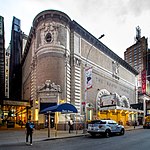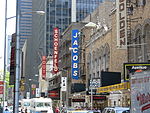Sardi's

Sardi's is a continental restaurant located at 234 West 44th Street, between Broadway and Eighth Avenue, in the Theater District of Manhattan, New York City. Sardi's opened at its current location on March 5, 1927. It is known for the caricatures of Broadway celebrities on its walls, of which there are over a thousand. Sardi's was founded by Vincent Sardi Sr. and his wife Jenny Pallera, who had previously operated a restaurant nearby between 1921 and 1926. To attract customers, Sardi Sr. hired Russian refugee Alex Gard to draw caricatures in exchange for free food. Even after Gard's death, Sardi's continued to commission caricatures. Following the death of Vincent Sardi Sr. in 1969, Sardi's started to decline in the 1980s, eventually being sold off in 1986. After closing temporarily in 1990, it reopened with new staff. The restaurant is today considered an institution in Broadway theatre. Over the years, the restaurant became known as a pre- and post-theater hangout, as well as a location for opening night parties, and was where the idea of the Tony Award was devised.
Excerpt from the Wikipedia article Sardi's (License: CC BY-SA 3.0, Authors, Images).Sardi's
West 44th Street, New York Manhattan
Geographical coordinates (GPS) Address Phone number Website External links Nearby Places Show on map
Geographical coordinates (GPS)
| Latitude | Longitude |
|---|---|
| N 40.757911111111 ° | E -73.987533333333 ° |
Address
Sardi's
West 44th Street 234
10036 New York, Manhattan
New York, United States
Open on Google Maps











